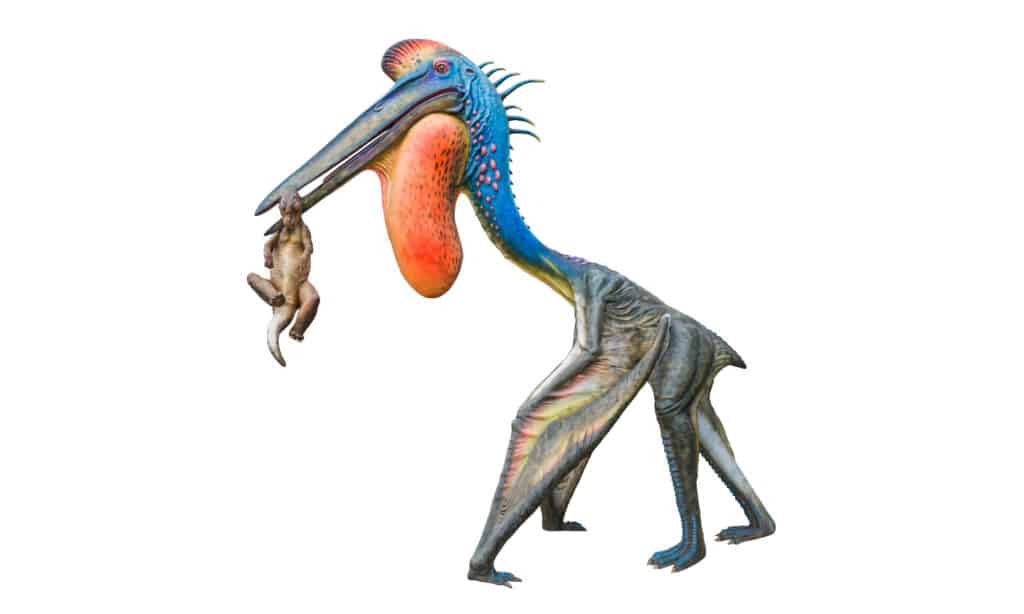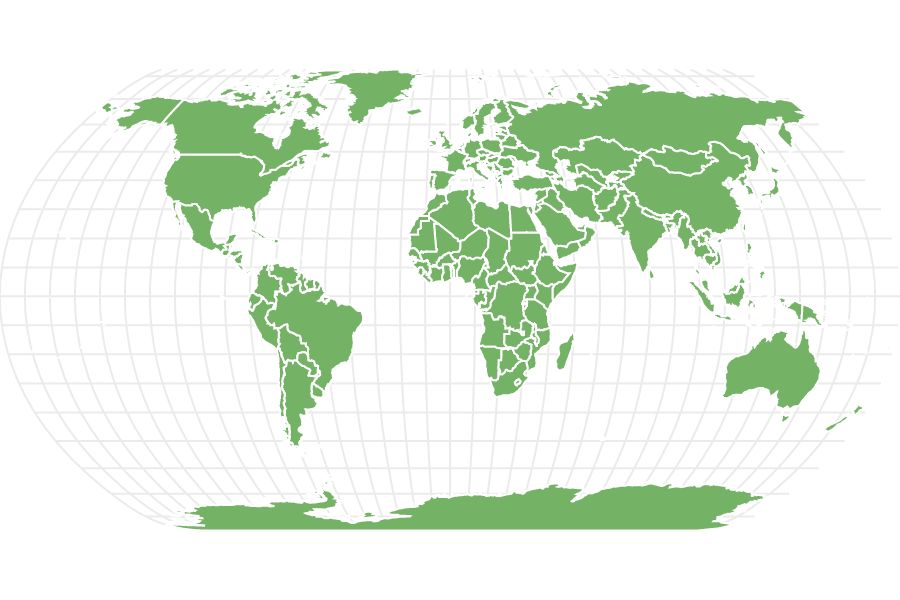Hatzegopteryx
Hatzegopteryx thambema
Hatzegopteryx was one of the largest flying animals to have ever lived.
Advertisement
Hatzegopteryx Scientific Classification
- Kingdom
- Animalia
- Phylum
- Chordata
- Order
- Pterosauria
- Family
- Azhdarchidae
- Genus
- Hatzegopteryx
- Scientific Name
- Hatzegopteryx thambema
Read our Complete Guide to Classification of Animals.
Hatzegopteryx Conservation Status
Hatzegopteryx Facts
- Prey
- dinosaurs and other azhdarchid pterosaurs
- Main Prey
- Dinosaurs
- Fun Fact
- Hatzegopteryx was one of the largest flying animals to have ever lived.
- Most Distinctive Feature
- Hatzegopteryx had a massive skull
- Distinctive Feature
- Massive jaw with a blunt beak
- Wingspan
- 33 to 39 feet
- Habitat
- Hateg Island
- Diet
- Carnivore
- Type
- Prehistoric flying reptile
- Special Features
- Hatzegopteryx was capable of opening its wide jaws very wide to swallow food.
- Number Of Species
- 1
View all of the Hatzegopteryx images!
Hatzegopteryx is an extinct pterosaur genus that lived during the Maastrichtian epoch. This unusually giant creature is one of the biggest flying animals known to have existed. Only one species of this creature is known. The pterosaur had an elongated head (resembling a stork), a fragile long neck, and a small body. It also had wings and was capable of powerful flights. Hatzegopteryx lived on Hațeg Island and was the apex predator on the island before its extinction.
Description and Size
Hatzegopteryx is a genus of flying reptiles that lived about 66 million years ago. Experts only know one species of this reptile from the Maastrichtian beds of Romania. The genus name “Hatzegopteryx” comes from the combination of two words; “Hatzeg,” in reference to Hateg Island, and “pteryx,” which means wings. In full, the name translates as “Hateg basin wings.” The specific name “thambema” is the Greek word for “terror” or “monster.”
Hatzegopteryx was a flying reptile and was one of the most enormous flying creatures ever found. It belongs to a group of prehistoric reptiles known as the azhdarchids. Members of this group are known for their ability to fly despite their massive size.
One of the most prominent features of this animal was the skull. The skull bones of Hatzegopteryx were massive, with an estimated length of up to 9.8 feet. The Hatzegopteryx had one of the largest skulls found in a non-marine animal. The skull was broad and robust too. It featured prominent ridges indicating they had strong muscle attachments. The creature had a massive jaw with a blunt beak. Hatzegopteryx was probably capable of opening its jaws very wide to swallow food.
The Hatzegopteryx’s neck was also heavily muscled, with an average length of up to 5 feet. This was short by azhdarchid standards, considering the fact that other flying reptiles with comparable wingspans tend to have necks about twice this length. The neck was flexible, and it could withstand strong bending forces.
The overall wingspan of this creature was about 39 feet. Establishing how big it really was has been challenging because the fossils recovered so far are fragmentary. This pterosaur was approximately 18 feet tall and weighed around 250 pounds.

was a flying reptile as tall as a
giraffe
and was one of the most enormous flying creatures ever found.
©YuRi Photolife/Shutterstock.com
History and Evolution
Scientists discovered fossils of the Hatzegopteryx on Hateg Island, a subtropical landmass isolated from the mainland by an oceanic basin. Scientists believe animals insulated on islands this way would either exhibit unusual gigantism or dwarfism. This means they would grow bigger or smaller compared to their mainland relatives, depending on the conditions on the island. Expectedly, most dinosaurs on this island exhibited island dwarfism due to limited resources.
Interestingly, the Hatzegopteryx’s evolution went in the opposite direction. In fact, this pterosaur grew so big that paleontologists who discovered the fossils mistook it for a theropod dinosaur.
Stranded on an island with smaller and similarly sized animals, Hatzegopteryx developed a more aggressive hunting strategy compared to other flying reptiles about 70 million years ago. Consequently, it also developed physical traits such as a shorter and more robust neck that was up to 10 times stronger than those of similar-sized pterosaurs such as Quetzalcoatlus. These adaptations allowed the Hatzegopteryx to rise to the top of the food chain on Hateg Island.
Diet—What Did Hatzegopteryx Eat?
Hatzegopteryx was a carnivore and was at the top of the food chain on Hateg Island during the Late Cretaceous. The robust skeleton of the animal indicates that it might have even attacked prey larger than itself. The massive jaws also show evidence that it could gape wide, allowing the animal to swallow huge chunks of food at once.
The Hateg Island, where this pterosaur lived, was home to several dwarf dinosaurs. The massive size of the Hatzegopteryx meant it would have preyed on them quite easily. Some experts also think this animal was a foraging generalist that fed on various prey animals like other azhdarchid pterosaurs.
Habitat—When and Where It Lived
Hatzegopteryx lived on Hateg Island during the Maastrichtian. This was about 66 million years ago. The climate was subtropical, and the environment had alluvial plains and wetlands. The temperature of the Island was an average of 77 degrees Fahrenheit. The dinosaur remains found on the island show that the animals that lived there exhibited a phenomenon known as island dwarfism. This means the dinosaurs that lived on the Hateg island were smaller in size when compared to their mainland relatives. The limited food resources might have been the cause of this phenomenon. However, Hatzegopteryx thambema was an exception to this rule. The exact reason for this isn’t entirely clear.
Threats and Predators
There is no evidence of animals preying on Hatzegopteryx. At the time of its existence, there were no other big hypercarnivorous roaming about the region. It was a massive pterosaur in an environment with lots of ‘dwarf dinosaurs,’ which made it the apex predator on the Island. Hatzegopteryx lived towards the end of the Cretaceous period. It was a time of major changes in the planet’s ecosystem, and many of the earth’s major species died off due to a wide range of natural factors.
Discoveries and Fossils—Where Hatzegopteryx Was Found?
Experts discovered the first fossil of the species in 1991. Scientists recovered the fossil from the Densus Ciula Formation in the Hateg Basin. The basin, part of an offshore island on the Tethys sea, is now located in present-day Romania. The find included two bone fragments from the skull and humerus of this animal. However, scientists initially misidentified the skull fragment as a part of a theropod dinosaur due to its large size. Despite being discovered in 1991, Hatzegopteryx wasn’t named until 2002. Other remains were found at other sites that are probably from this dinosaur. However, these additional fossils have not been properly identified or described.
Extinction—When Did Hatzegopteryx Die Out?
Hatzegopteryx went into extinction some 66 million years ago. It was wiped out along with the rest of the non-avian dinosaurs as part of a worldwide extinction event. This unfortunate event killed about three-fourths of the species that lived during that period.
Similar Animals to the Hatzegopteryx
Similar animals to the Hatzegopteryx include:
- Arambourgiania — This is a genus of giant flying pterosaurs that lived in Jordan towards the end of the Cretaceous. It had a wingspan of 36–43 feet, slightly bigger than the Hatzegopteryx. Thus, Arambourgiania is considered one of the largest flying creatures ever found.
- Quetzalcoatlus — Like the Hatzegopteryx, Quetzalcoatlus was a flying reptile that lived in North America during the Cretaceous. Many of the fossils of this pterosaur were very similar to that of Hatzegopteryx. However, the jaw articulation of the animals was slightly different.
- Banguela — Banguela lived during the Early Cretaceous in an area that is now in present-day Brazil. Little is known about the species as a result of its poor fossil record. It had a wingspan of about 12 feet.
- Pteranodon — Pteranodon is an extinct pterosaur that lived in North America during the Cretaceous. With a wingspan of 21 feet, it is known as one of the largest flying reptiles to have been in existence. Of all discovered pterosaurs, Pteranodon is one of the most well-known due to the abundance of fossils. Approximately 1200 specimens with well-articulated skeletons and almost complete skulls have been recovered.
Related Animals
View all 104 animals that start with HHatzegopteryx FAQs (Frequently Asked Questions)
When was the Hatzegopteryx alive?
Hatzegopteryx lived between 70.6 and 66 million years ago. This was during the Maastrichtian epoch, towards the end of the Cretaceous Period. It inhabited Europe, and fossils of this animal have been found on Hateg Island.
How big was the Hatzegopteryx?
Estimates show that the Hatzegopteryx was probably as tall as a giraffe, with an average height of up to 18 feet. It had a wingspan of about 33 to 39 ft (10 to 12 meters). Despite being such a large animal, the hollow bones helped to keep the weight on the low side. It had an average weight of about 250 pounds.
Was Hatzegopteryx the biggest pterosaur?
Hatzegopteryx was one of the biggest pterosaurs and also one of the largest flying animals ever found. It had a wingspan of about 39 feet, rivaling that of many other flying reptiles from the Americas, Asia, and other parts of the world.
Thank you for reading! Have some feedback for us? Contact the AZ Animals editorial team.
Sources
- Wikipedia, Available here: https://en.wikipedia.org/wiki/Hatzegopteryx
- Earth Archives, Available here: https://eartharchives.org/articles/hatzegopteryx-transylvania-s-dinosaur-hunter/index.html
- New Dinosaurs, Available here: https://www.newdinosaurs.com/hatzegopteryx/

















